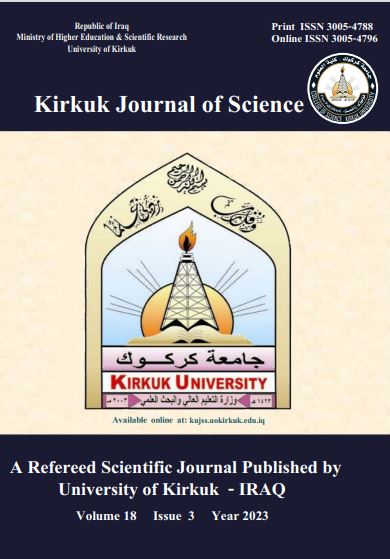Abstract
A simulation compression refrigeration system study was presented in this
research depending on the change of the capillary tube diameter and using the
refrigerants (R134a, R12, R500 and R152a).
the tests were done for two capillary tube diameters (2.25,3mm) and changing
the volumetric flow rate range for (R134a) (0.15-0.3L/min) with fixed capillary tube
length at (L=130cm).
The results showed that for (R152a, R134a Exp.) the (COP) decreases by
(11.37,22.8%) respectively as the mass flow rate increases by (58.71%), and decreases
by (6.34,7.66%) respectively as the capillary tube diameter increases, while the values
of (COP) for (R134a Theo.,R12,R500) are converged. Also it was declared that when
the condenser temperature increases by (1.73%) the (COP) for all refrigerants and for
both capillary tube diameters will decrease.
The study showed that the compressor compression power increases by (72.43,
65.73%) as the condenser temperature increases, and decreases as the capillary tube
diameter increases by (8.78, 7.5%) for refrigerants (R152a, R134a Exp.) respectively,
with convergence the values of (TCP) for (R134a Theo.,R12,R500). Also this study
showed that the cooling capacity increases for all refrigerants, where the largest value
was for (R152a) and the lowest value was for (R134a Exp.), as the evaporator
temperature increases by (3.81%) ,but the cooling capacity decreases as the capillary
tube diameter increases.
Through this study it was found that the best diameter used is (2.25 mm) at
fixed length, with decreasing the capillary tube diameter from (3 to 2.25 mm) and at
volumetric flow rate (0.2 L/min) it was found as an average for all refrigerants
increasing for compression power by (4.2%), increasing of cooling capacity by (10.2%)
and decreasing the coefficient of performance by (5.8%).
research depending on the change of the capillary tube diameter and using the
refrigerants (R134a, R12, R500 and R152a).
the tests were done for two capillary tube diameters (2.25,3mm) and changing
the volumetric flow rate range for (R134a) (0.15-0.3L/min) with fixed capillary tube
length at (L=130cm).
The results showed that for (R152a, R134a Exp.) the (COP) decreases by
(11.37,22.8%) respectively as the mass flow rate increases by (58.71%), and decreases
by (6.34,7.66%) respectively as the capillary tube diameter increases, while the values
of (COP) for (R134a Theo.,R12,R500) are converged. Also it was declared that when
the condenser temperature increases by (1.73%) the (COP) for all refrigerants and for
both capillary tube diameters will decrease.
The study showed that the compressor compression power increases by (72.43,
65.73%) as the condenser temperature increases, and decreases as the capillary tube
diameter increases by (8.78, 7.5%) for refrigerants (R152a, R134a Exp.) respectively,
with convergence the values of (TCP) for (R134a Theo.,R12,R500). Also this study
showed that the cooling capacity increases for all refrigerants, where the largest value
was for (R152a) and the lowest value was for (R134a Exp.), as the evaporator
temperature increases by (3.81%) ,but the cooling capacity decreases as the capillary
tube diameter increases.
Through this study it was found that the best diameter used is (2.25 mm) at
fixed length, with decreasing the capillary tube diameter from (3 to 2.25 mm) and at
volumetric flow rate (0.2 L/min) it was found as an average for all refrigerants
increasing for compression power by (4.2%), increasing of cooling capacity by (10.2%)
and decreasing the coefficient of performance by (5.8%).
Abstract
تم في هذا البحث دراسة محاكاة أداء منظومة التثليج الانضغاطية بالاعتماد على تغيير قطر الأنبوب الشعري وباستخدام موائع التثليج (R134a,R12,R500,R152a). أجريت الاختبارات العملية لقطرين مختلفين للأنبوب الشعري (2.25,3mm) مع تغيير معدل التدفق ألحجمي للمائع(R134a) وكانت تتراوح بين (0.15-0.3 L/min) مع ثبوت طول الأنبوب الشعري (L=130 cm). بينت النتائج المستحصلة للمائعين (R134a Exp.,R152a) إن معامل الأداء للمنظومة يقل بنسبة (22.8,11.37%)على التوالي كلما زاد معدل التدفق الكتلي بنسبة (58.71%) ويقل بزيادة قطر الأنبوب الشعري بنسبة (7.66,6.34%)على التوالي بينما تتقارب قيم معامل الأداء للموائع (R134a Theo.,R12,R500), كما بينت النتائج انه بزيادة درجة حرارة المكثف بنسبة(1.73%) تؤدي إلى نقصان معامل الأداء لجميع الموائع ولكلا قطري الأنبوب الشعري. وتبين من الدراسة أن القدرة الأنضغاطية للضاغط تزداد مع زيادة درجة حرارة المكثف بنسبة(65.73,72.43%) وتقل بزيادة القطر بنسبة(7.51,8.78%) للمائعين (R134a Exp.,R152a) على التوالي مع تقارب قيم القدرة الأنضغاطية للموائع (R134a Theo.,R12,R500)، وأظهرت الدراسة أيضا زيادة سعة التثليج للمنظومة لجميع الموائع وكانت أكبر قيمة للمائع(R152a) وأقل قيمة للمائع(R134a Exp.) عند زيادة درجة حرارة المبخر بنسبة(3.81%)، وبزيادة قطر الأنبوب الشعري تقل سعة التثليج، وعند تقليل قطر الأنبوب من (3mm) إلى (2.25mm) وللتدفق ألحجمي (0.2L/min) وجدنا كمعدل لجميع الموائع زيادة في القدرة الأنضغاطية بنسبة(4.2%) وزيادة في سعة التثليج بنسبة (10.2%) ونقصان في معامل الأداء بنسبة (5.8%).
Keywords
أداء منظومة
التثليج الأنضغاطية
تأثير التغير
قطر الأنبوب الشعري
محاكاة
